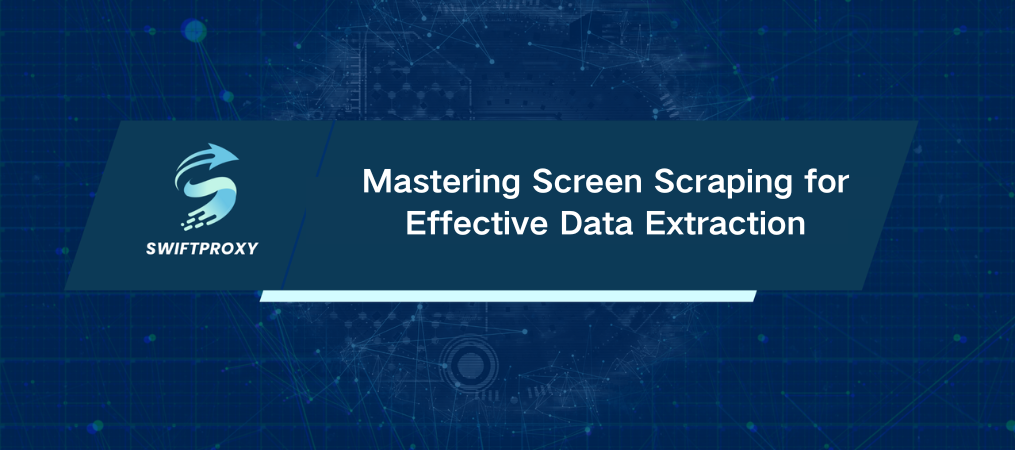Mastering Screen Scraping for Effective Data Extraction

In today's digital age, businesses are facing a data overload. With websites becoming more interactive and protected against traditional scraping methods, data retrieval is harder than ever. Enter screen scraping—a game-changing technique that's taking the world of data extraction by storm.
Understanding Screen Scraping
Screen scraping, also known as image or screenshot scraping, is a technique that simulates human interaction with a screen to extract data directly from visual content. Unlike traditional web scraping, which depends on a website's HTML structure, screen scraping captures everything displayed visually, including elements rendered by JavaScript, CSS, and dynamic content. This means it can retrieve data that traditional scraping methods often miss, especially dynamic content like images and complex interfaces.
How Does It Work
At its core, screen scraping mimics the actions of a human user. Specialized tools or software simulate clicks, scrolling, and other user interactions to capture screen content. Here's how it works in a nutshell:
1.Mimic Actions: The software acts like a user by opening websites, scrolling, or clicking on elements.
2.Snap Screenshots: It captures the screen's content, which could be a full page or specific areas of interest.
3.OCR Recognition: Optical Character Recognition (OCR) scans the image for text, converting it into usable, editable data.
4.Data Output: The scraped data is then stored, analyzed, or exported in the required format.
Screen scraping isn't just about text. It also captures images, videos, PDFs, and other media that are traditionally difficult to retrieve through standard web scraping techniques.
Screen Scraping vs. Web Scraping
Web scraping and screen scraping are both popular techniques for extracting data, but they serve different purposes and have distinct strengths.
Web scraping focuses on extracting data from the HTML structure, DOM elements, and source code of a page. It's best suited for static content, such as articles or tables, where the structure remains relatively stable. The technical complexity of web scraping is lower, making it easy to implement, but it can be fragile and easily broken by changes to the page structure. While it's stable for well-maintained pages, any changes to the layout can lead to scraping errors.
On the other hand, screen scraping works by capturing visual content, including JavaScript-rendered elements that are typically dynamic in nature. It's ideal for complex sites with interactive interfaces, images, or content that requires bypassing anti-scraping measures like CAPTCHA. Screen scraping is more technically complex and demands more resources, but it can adapt well to complex sites. It is generally more stable when dealing with dynamic content, although it may require additional technical support to maintain.
Real-World Applications of Screen Scraping
Screen scraping is being put to good use across industries. Here are a few examples:
Competitive Market Analysis: Want to stay ahead of the competition? Screen scraping lets you monitor competitors' pricing, promotions, and stock levels in real-time—bypassing many anti-scraping measures they've put in place.
E-Commerce: On e-commerce platforms, product information is often dynamically loaded. Traditional scraping tools can miss these details. Screen scraping, however, can retrieve product descriptions, prices, reviews, and ratings, helping you gather valuable insights for market research.
Finance: Financial data, such as stock prices, is often loaded dynamically. Screen scraping helps investors access real-time market data, enabling them to make faster, more informed decisions.
Content Scraping and Monitoring: News outlets or blogs with dynamic content (like JavaScript-based comments or articles) benefit from screen scraping. It can extract articles, comments, and other dynamic elements that would be impossible to pull using traditional methods.
How Swiftproxy Supercharges Your Screen Scraping
While screen scraping is powerful, many websites impose restrictions like IP blocking and CAPTCHA to prevent unauthorized data extraction. That's where Swiftproxy comes in.
Swiftproxy helps overcome these obstacles by providing anonymous, high-performance proxies that mask your real IP address, making it difficult for websites to block or track you. Here's how it boosts your scraping efforts:
Overcome Access Restrictions: Swiftproxy helps you avoid IP bans and CAPTCHA challenges, allowing you to scrape data uninterrupted.
Global Access: With access to proxies from around the world, Swiftproxy enables you to bypass regional restrictions and scrape data from any corner of the globe.
Boost Scraping Efficiency: Frequent access or large-scale scraping? Swiftproxy reduces the chances of being blocked, improving your scraping success rate.
Data Privacy: Swiftproxy ensures your privacy with anonymous proxies, safeguarding your data and complying with relevant regulations.
Conclusion
Screen scraping is more than just a trend—it's a powerful tool for navigating the increasingly complex world of web data extraction. Whether you're working with dynamic content, interactive elements, or complex anti-scraping barriers, screen scraping provides an efficient solution to retrieve the data you need. With the help of tools like Swiftproxy, you can enhance your scraping capabilities, ensuring you access accurate, timely information while protecting your privacy.

















































